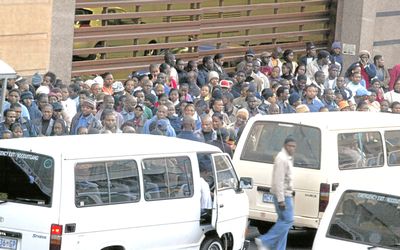A SPEED-triggered warning tone fitted to minibus taxis can cut down on accidents, researchers at Stellenbosch University’s Department of Electrical and Electronic Engineering have found.
The research found that the impact of a loud speed-triggered warning sound improved compliance with traffic rules.
The study focused on minibus taxis, which carry at least 65% of those who use public transport and are blamed for many fatalities.
In 72% of the trips studied, taxis spent more than 80% of each trip over the speed limit. With the loud warning tone, this figure was reduced to only 20% of trips.
Senior lecturer Thinus Booysen, who conducted the study, said speed compliance and road safety interventions (such as average speed enforcement (ASE) had not led to a decline in taxi accidents.
Despite evidence that ASE significantly reduces speeding in developed countries, and despite it seemingly working in South Africa for passenger vehicles, "our analysis of the speeding patterns showed that taxi drivers appear oblivious to South Africa’s first ASE on the R61 between Beaufort West and Aberdeen", he said.
He said of 21 drivers, only two understood ASE at all.
"This was further illustrated by average speeds of around 60km/h within 300m of one of the ASE cameras, and an average speed of around 115km/h on the rest of the route — indicating that drivers considered the ASE camera to be an instantaneous speeding camera."
He said the warning tone had a positive impact on behaviour for taxis on the R61 between Beaufort West and Aberdeen, when applied at an audible level that can be drowned out by a radio and an even greater impact at a loud level.
"We tested the warning tone at two volumes: one that could be drowned out by loud music, and one that could not be ignored. The impact of the audible warning tone was stark: With the loud activation, the mean speeds of all of the trips completed were below 120 km/h, and only 40% of trips had a mean speed above 110 km/h."
According to Mr Booysen, a key finding was that drivers stuck to the speed limit after the researchers remotely deactivated the warning tone. Drivers were not able to turn it off themselves.
He said the warning tone helped taxi operators gauge the impact of speeding on fuel consumption.
The speed limit for taxis is 100km/h but many drivers think it is 120km/h. "When compared to the normal driving we observed, the speeds driven during the warning tone activation led to a 30% improvement in fuel efficiency, which means a driver can increase his remuneration for the return trip between Cape Town and Mthatha with over R1,000 by keeping to the speed limit."
The study was conducted with Nelson Ebot Eno Akpa of the department of electrical and electronic engineering and Marion Sinclair from the department of civil engineering.





















Change: -0.42%
Change: -0.35%
Change: -0.17%
Change: 0.14%
Change: -2.58%
Data supplied by Profile Data
Change: -0.56%
Change: 0.13%
Change: -0.42%
Change: 0.00%
Change: -0.18%
Data supplied by Profile Data
Change: 0.15%
Change: -0.06%
Change: 0.00%
Change: -0.07%
Change: 0.24%
Data supplied by Profile Data
Change: 0.08%
Change: 0.84%
Change: 0.13%
Change: -0.53%
Change: 0.44%
Data supplied by Profile Data